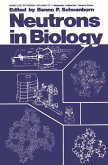- Broschiertes Buch
- Merkliste
- Auf die Merkliste
- Bewerten Bewerten
- Teilen
- Produkt teilen
- Produkterinnerung
- Produkterinnerung
This volume contains the contributions from the speakers at the NATO Advanced Research Workshop on "Structure of the Photosynthetic Bacterial Reaction Center X-ray Crystallography and Optical Spectroscopy with Polarized Light" which was held at the "Maison d'Hotes" of the Centre d'Etudes Nucleaires de Cadarache in the South of France, 20-25 September, 1987. This meeting continued in the spirit of a previous workshop which took place in Feldafing (FRG), March 1985. Photosynthetic reaction centers are intrinsic membrane proteins which, by performing a photoinduced transmembrane charge…mehr
Andere Kunden interessierten sich auch für
![Membrane Bioenergetics Membrane Bioenergetics]() Vladimir P. SkulachevMembrane Bioenergetics77,99 €
Vladimir P. SkulachevMembrane Bioenergetics77,99 €![High Pressure Bioscience High Pressure Bioscience]() High Pressure Bioscience156,99 €
High Pressure Bioscience156,99 €![Davydov¿s Soliton Revisited Davydov¿s Soliton Revisited]() Davydov¿s Soliton Revisited154,99 €
Davydov¿s Soliton Revisited154,99 €![Bioenergetics Bioenergetics]() Chong H. KimBioenergetics39,99 €
Chong H. KimBioenergetics39,99 €![Neutrons in Biology Neutrons in Biology]() Benno P. SchoenbornNeutrons in Biology116,99 €
Benno P. SchoenbornNeutrons in Biology116,99 €![Protein Dynamics, Function, and Design Protein Dynamics, Function, and Design]() Protein Dynamics, Function, and Design37,99 €
Protein Dynamics, Function, and Design37,99 €![Biochemistry of Scandium and Yttrium, Part 1: Physical and Chemical Fundamentals Biochemistry of Scandium and Yttrium, Part 1: Physical and Chemical Fundamentals]() Chaim T. HorovitzBiochemistry of Scandium and Yttrium, Part 1: Physical and Chemical Fundamentals110,99 €
Chaim T. HorovitzBiochemistry of Scandium and Yttrium, Part 1: Physical and Chemical Fundamentals110,99 €-
-
-
This volume contains the contributions from the speakers at the NATO Advanced Research Workshop on "Structure of the Photosynthetic Bacterial Reaction Center X-ray Crystallography and Optical Spectroscopy with Polarized Light" which was held at the "Maison d'Hotes" of the Centre d'Etudes Nucleaires de Cadarache in the South of France, 20-25 September, 1987. This meeting continued in the spirit of a previous workshop which took place in Feldafing (FRG), March 1985. Photosynthetic reaction centers are intrinsic membrane proteins which, by performing a photoinduced transmembrane charge separation, are responsible for the conversion and storage of solar energy. Since the pioneering work of Reed and Clayton (1968) on the isolation of the reaction center from photosynthetic bacteria, optical spectroscopy with polarized light has been one of the main tools used to investigate the geometrical arrangement of the various chromophores in these systems. The recent elucidation by X-ray crystallography of the structure of several bacterial reaction centers, a breakthrough initiated by Michel and Deisenhofer, has provided us with the atomic coordinates of the pigments and some details about their interactions with neighboring aminoacid residues. This essential step has given a large impetus both to experimentalists and to theoreticians who are now attempting to relate the X-ray structural model to the optical properties of the reaction center and ultimately to its primary biological function.
Produktdetails
- Produktdetails
- Nato Science Series A: 149
- Verlag: Springer / Springer US / Springer, Berlin
- Artikelnr. des Verlages: 978-1-4899-0817-9
- Softcover reprint of the original 1st ed. 1988
- Seitenzahl: 460
- Erscheinungstermin: 29. Mai 2013
- Englisch
- Abmessung: 235mm x 155mm x 25mm
- Gewicht: 692g
- ISBN-13: 9781489908179
- ISBN-10: 148990817X
- Artikelnr.: 39934048
- Nato Science Series A: 149
- Verlag: Springer / Springer US / Springer, Berlin
- Artikelnr. des Verlages: 978-1-4899-0817-9
- Softcover reprint of the original 1st ed. 1988
- Seitenzahl: 460
- Erscheinungstermin: 29. Mai 2013
- Englisch
- Abmessung: 235mm x 155mm x 25mm
- Gewicht: 692g
- ISBN-13: 9781489908179
- ISBN-10: 148990817X
- Artikelnr.: 39934048
The Crystal Structure of the Photosynthetic Reaction Center from Rhodopseudomonas viridis.- Structure of the Reaction Center from Rhodobacter sphaeroides R-26 and 2.4.1.- Symmetry Breaking Structures Involved in the Docking of Cytochrome c and Primary Electron Transfer in Reaction Centers of Rhodobacter sphaeroides.- Crystallographic Studies of the Photosynthetic Reaction Center from Wild Type Rhodobacter sphaeroides (Y Strain).- Single Crystals of the Photochemical Reaction Center from Rhodobacter sphaeroides Wild Type Strain 2.4.1. Analyzed by Polarized Light.- Spectroscopic Studies of Crystallized Pigment-protein Complexes of R. palustris.- Protein-prosthetic Group Interactions in Bacterial Reaction Centers.- Circular Dichroism Spectroscopy of Photoreaction Centers.- Low Temperature Linear Dichroism Study of the Orientation of the Pigments in Reduced and Oxidized Reaction Centers of Rps. viridis and Rb. sphaeroides.- Anisotropic Magnetic Field Effects of the Photosynthetic Bacterial Reaction Center of Rhodobacter sphaeroides R-26, Studied by Linear Dichroic Magneto-optical Difference Spectroscopy (LD-MODS) in the Temperature Range 1.2-310K.- Bacterial Reaction Centers are Intrinsically Heterogeneous.- Reaction Centers of Purple Bacteria with Modified Chromophores.- Quantitative Analysis of Genetically Altered Reaction Centers Using an In Vitro Cytochrome Oxidation Assay.- Properties of Reaction Centers From the Green Photosynthetic Bacterium Chloroflexus aurantiacus.- Structural and Functional Properties of the Reaction Center of Green Bacteria and Heliobacteria.- Molecular Dynamics Simulation of the Primary Processes in the Photosynthetic Reaction Center of Rhodopseudomonas viridis.- The Stark Effect in Photosynthetic Reaction Centers from Rhodobacter sphaeroidesR-26, Rhodopseudomonas viridis and the D1 D2 Complex of Photosystem II from Spinach.- The Nature of Excited States and Intermediates in Bacterial Photosynthesis.- On the Energetics of the States 1P*, 3P* and P+H? in Reaction Centers of Rb. sphaeroides.- The Possible Existence of a Charge Transfer State which Preceeds the Formation of (BChl)2+ BPh? in Rhodobacter sphaeroides Reaction Centers.- The Primary Electron Transfer in Photosynthetic Purple Bacteria: Long Range Electron Transfer in the Femtosecond Domain at Low Temperature.- The Problem of Primary Energy Conversion in Reaction Centers of Photosynthetic Bacteria.- Temperature Effects on the Ground State Absorption Spectra and Electron Transfer Kinetics of Bacterial Reaction Centers.- ENDOR of Exchangeable Protons of the Reduced Intermediate Acceptor in Reaction Centers from Rhodobacter sphaeroides R-26.- FTIR Spectroscopic Investigations of the Intermediary Electron Acceptor Photoreduction in Purple Photosynthetic Bacteria and Green Plants.- Charge Recombination at Low Temperature in Photosynthetic Bacteria Reaction Centers.- Temperature and - ?G° Dependence of the Electron Transfer to and from QA in Reaction Center Protein from Rhodobacter sphaeroides.- The Effect of an Electric Field on the Charge Recombination Rate of D+QA? ? DQA in Reaction Centers from Rhodobacter sphaeroides R-26.- Pressure Effects on Electron Transfer in Bacterial Reaction Centers.- The Spectral Properties of Chlorophyll and Bacteriochlorophyll Dimers; a Comparative Study.- Spectroscopic Properties and Electron Transfer Dynamics of Reaction Centers.- Analysis of A, LD, CD, ADMR and LD-ADMR Spectra for the Reaction Centers of Rps. viridis, Rb. sphaeroides, C. aurantiacus and Modified Rb. sphaeroides.- Modified-CI Model ofProtein-induced Red Shifts of Reaction Center Pigment Spectra.- Temperature Dependence of the Long Wavelength Absorption Band of the Reaction Center of Rhodopseudomonas viridis.- Discussion of the Large Homogeneous Width of the P-Band in Bacterial- and Plant Reaction Centers.- Theoretical Models of Electrochromic and Environmental Effects on Bacterio-Chloropbylls and -Pheophytins in Reaction Centers.- Electrostatic Control of Electron Transfer in the Photosynthetic Reaction Center of Rhodopseudomonas viridis.- Molecular Orbital Studies on the Primary Donor P960 in Reaction Centers of Rps. viridis.- Early Steps in Bacterial Photosynthesis. Comparison of Three Mechanisms.- Mechanism of the Primary Charge Separation in Bacterial Photosynthetic Reaction Centers.- A Configuration Interaction (CI) Description of Vectorial Electron Transfer in Bacterial Reaction Centers.- Charge Transfer States and the Mechanism of Charge Separation in Bacterial Reaction Centers.- Light Reflections.
The Crystal Structure of the Photosynthetic Reaction Center from
Rhodopseudomonas viridis.- Structure of the Reaction Center from
Rhodobacter sphaeroides R-26 and 2.4.1.- Symmetry Breaking Structures
Involved in the Docking of Cytochrome c and Primary Electron Transfer in
Reaction Centers of Rhodobacter sphaeroides.- Crystallographic Studies of
the Photosynthetic Reaction Center from Wild Type Rhodobacter sphaeroides
(Y Strain).- Single Crystals of the Photochemical Reaction Center from
Rhodobacter sphaeroides Wild Type Strain 2.4.1. Analyzed by Polarized
Light.- Spectroscopic Studies of Crystallized Pigment-protein Complexes of
R. palustris.- Protein-prosthetic Group Interactions in Bacterial Reaction
Centers.- Circular Dichroism Spectroscopy of Photoreaction Centers.- Low
Temperature Linear Dichroism Study of the Orientation of the Pigments in
Reduced and Oxidized Reaction Centers of Rps. viridis and Rb. sphaeroides.-
Anisotropic Magnetic Field Effects of the Photosynthetic Bacterial Reaction
Center of Rhodobacter sphaeroides R-26, Studied by Linear Dichroic
Magneto-optical Difference Spectroscopy (LD-MODS) in the Temperature Range
1.2-310K.- Bacterial Reaction Centers are Intrinsically Heterogeneous.-
Reaction Centers of Purple Bacteria with Modified Chromophores.-
Quantitative Analysis of Genetically Altered Reaction Centers Using an In
Vitro Cytochrome Oxidation Assay.- Properties of Reaction Centers From the
Green Photosynthetic Bacterium Chloroflexus aurantiacus.- Structural and
Functional Properties of the Reaction Center of Green Bacteria and
Heliobacteria.- Molecular Dynamics Simulation of the Primary Processes in
the Photosynthetic Reaction Center of Rhodopseudomonas viridis.- The Stark
Effect in Photosynthetic Reaction Centers from Rhodobacter sphaeroidesR-26,
Rhodopseudomonas viridis and the D1 D2 Complex of Photosystem II from
Spinach.- The Nature of Excited States and Intermediates in Bacterial
Photosynthesis.- On the Energetics of the States 1P*, 3P* and P+H? in
Reaction Centers of Rb. sphaeroides.- The Possible Existence of a Charge
Transfer State which Preceeds the Formation of (BChl)2+ BPh? in Rhodobacter
sphaeroides Reaction Centers.- The Primary Electron Transfer in
Photosynthetic Purple Bacteria: Long Range Electron Transfer in the
Femtosecond Domain at Low Temperature.- The Problem of Primary Energy
Conversion in Reaction Centers of Photosynthetic Bacteria.- Temperature
Effects on the Ground State Absorption Spectra and Electron Transfer
Kinetics of Bacterial Reaction Centers.- ENDOR of Exchangeable Protons of
the Reduced Intermediate Acceptor in Reaction Centers from Rhodobacter
sphaeroides R-26.- FTIR Spectroscopic Investigations of the Intermediary
Electron Acceptor Photoreduction in Purple Photosynthetic Bacteria and
Green Plants.- Charge Recombination at Low Temperature in Photosynthetic
Bacteria Reaction Centers.- Temperature and - ?G° Dependence of the
Electron Transfer to and from QA in Reaction Center Protein from
Rhodobacter sphaeroides.- The Effect of an Electric Field on the Charge
Recombination Rate of D+QA? ? DQA in Reaction Centers from Rhodobacter
sphaeroides R-26.- Pressure Effects on Electron Transfer in Bacterial
Reaction Centers.- The Spectral Properties of Chlorophyll and
Bacteriochlorophyll Dimers; a Comparative Study.- Spectroscopic Properties
and Electron Transfer Dynamics of Reaction Centers.- Analysis of A, LD, CD,
ADMR and LD-ADMR Spectra for the Reaction Centers of Rps. viridis, Rb.
sphaeroides, C. aurantiacus and Modified Rb. sphaeroides.- Modified-CI
Model ofProtein-induced Red Shifts of Reaction Center Pigment Spectra.-
Temperature Dependence of the Long Wavelength Absorption Band of the
Reaction Center of Rhodopseudomonas viridis.- Discussion of the Large
Homogeneous Width of the P-Band in Bacterial- and Plant Reaction Centers.-
Theoretical Models of Electrochromic and Environmental Effects on
Bacterio-Chloropbylls and -Pheophytins in Reaction Centers.- Electrostatic
Control of Electron Transfer in the Photosynthetic Reaction Center of
Rhodopseudomonas viridis.- Molecular Orbital Studies on the Primary Donor
P960 in Reaction Centers of Rps. viridis.- Early Steps in Bacterial
Photosynthesis. Comparison of Three Mechanisms.- Mechanism of the Primary
Charge Separation in Bacterial Photosynthetic Reaction Centers.- A
Configuration Interaction (CI) Description of Vectorial Electron Transfer
in Bacterial Reaction Centers.- Charge Transfer States and the Mechanism of
Charge Separation in Bacterial Reaction Centers.- Light Reflections.
Rhodopseudomonas viridis.- Structure of the Reaction Center from
Rhodobacter sphaeroides R-26 and 2.4.1.- Symmetry Breaking Structures
Involved in the Docking of Cytochrome c and Primary Electron Transfer in
Reaction Centers of Rhodobacter sphaeroides.- Crystallographic Studies of
the Photosynthetic Reaction Center from Wild Type Rhodobacter sphaeroides
(Y Strain).- Single Crystals of the Photochemical Reaction Center from
Rhodobacter sphaeroides Wild Type Strain 2.4.1. Analyzed by Polarized
Light.- Spectroscopic Studies of Crystallized Pigment-protein Complexes of
R. palustris.- Protein-prosthetic Group Interactions in Bacterial Reaction
Centers.- Circular Dichroism Spectroscopy of Photoreaction Centers.- Low
Temperature Linear Dichroism Study of the Orientation of the Pigments in
Reduced and Oxidized Reaction Centers of Rps. viridis and Rb. sphaeroides.-
Anisotropic Magnetic Field Effects of the Photosynthetic Bacterial Reaction
Center of Rhodobacter sphaeroides R-26, Studied by Linear Dichroic
Magneto-optical Difference Spectroscopy (LD-MODS) in the Temperature Range
1.2-310K.- Bacterial Reaction Centers are Intrinsically Heterogeneous.-
Reaction Centers of Purple Bacteria with Modified Chromophores.-
Quantitative Analysis of Genetically Altered Reaction Centers Using an In
Vitro Cytochrome Oxidation Assay.- Properties of Reaction Centers From the
Green Photosynthetic Bacterium Chloroflexus aurantiacus.- Structural and
Functional Properties of the Reaction Center of Green Bacteria and
Heliobacteria.- Molecular Dynamics Simulation of the Primary Processes in
the Photosynthetic Reaction Center of Rhodopseudomonas viridis.- The Stark
Effect in Photosynthetic Reaction Centers from Rhodobacter sphaeroidesR-26,
Rhodopseudomonas viridis and the D1 D2 Complex of Photosystem II from
Spinach.- The Nature of Excited States and Intermediates in Bacterial
Photosynthesis.- On the Energetics of the States 1P*, 3P* and P+H? in
Reaction Centers of Rb. sphaeroides.- The Possible Existence of a Charge
Transfer State which Preceeds the Formation of (BChl)2+ BPh? in Rhodobacter
sphaeroides Reaction Centers.- The Primary Electron Transfer in
Photosynthetic Purple Bacteria: Long Range Electron Transfer in the
Femtosecond Domain at Low Temperature.- The Problem of Primary Energy
Conversion in Reaction Centers of Photosynthetic Bacteria.- Temperature
Effects on the Ground State Absorption Spectra and Electron Transfer
Kinetics of Bacterial Reaction Centers.- ENDOR of Exchangeable Protons of
the Reduced Intermediate Acceptor in Reaction Centers from Rhodobacter
sphaeroides R-26.- FTIR Spectroscopic Investigations of the Intermediary
Electron Acceptor Photoreduction in Purple Photosynthetic Bacteria and
Green Plants.- Charge Recombination at Low Temperature in Photosynthetic
Bacteria Reaction Centers.- Temperature and - ?G° Dependence of the
Electron Transfer to and from QA in Reaction Center Protein from
Rhodobacter sphaeroides.- The Effect of an Electric Field on the Charge
Recombination Rate of D+QA? ? DQA in Reaction Centers from Rhodobacter
sphaeroides R-26.- Pressure Effects on Electron Transfer in Bacterial
Reaction Centers.- The Spectral Properties of Chlorophyll and
Bacteriochlorophyll Dimers; a Comparative Study.- Spectroscopic Properties
and Electron Transfer Dynamics of Reaction Centers.- Analysis of A, LD, CD,
ADMR and LD-ADMR Spectra for the Reaction Centers of Rps. viridis, Rb.
sphaeroides, C. aurantiacus and Modified Rb. sphaeroides.- Modified-CI
Model ofProtein-induced Red Shifts of Reaction Center Pigment Spectra.-
Temperature Dependence of the Long Wavelength Absorption Band of the
Reaction Center of Rhodopseudomonas viridis.- Discussion of the Large
Homogeneous Width of the P-Band in Bacterial- and Plant Reaction Centers.-
Theoretical Models of Electrochromic and Environmental Effects on
Bacterio-Chloropbylls and -Pheophytins in Reaction Centers.- Electrostatic
Control of Electron Transfer in the Photosynthetic Reaction Center of
Rhodopseudomonas viridis.- Molecular Orbital Studies on the Primary Donor
P960 in Reaction Centers of Rps. viridis.- Early Steps in Bacterial
Photosynthesis. Comparison of Three Mechanisms.- Mechanism of the Primary
Charge Separation in Bacterial Photosynthetic Reaction Centers.- A
Configuration Interaction (CI) Description of Vectorial Electron Transfer
in Bacterial Reaction Centers.- Charge Transfer States and the Mechanism of
Charge Separation in Bacterial Reaction Centers.- Light Reflections.
The Crystal Structure of the Photosynthetic Reaction Center from Rhodopseudomonas viridis.- Structure of the Reaction Center from Rhodobacter sphaeroides R-26 and 2.4.1.- Symmetry Breaking Structures Involved in the Docking of Cytochrome c and Primary Electron Transfer in Reaction Centers of Rhodobacter sphaeroides.- Crystallographic Studies of the Photosynthetic Reaction Center from Wild Type Rhodobacter sphaeroides (Y Strain).- Single Crystals of the Photochemical Reaction Center from Rhodobacter sphaeroides Wild Type Strain 2.4.1. Analyzed by Polarized Light.- Spectroscopic Studies of Crystallized Pigment-protein Complexes of R. palustris.- Protein-prosthetic Group Interactions in Bacterial Reaction Centers.- Circular Dichroism Spectroscopy of Photoreaction Centers.- Low Temperature Linear Dichroism Study of the Orientation of the Pigments in Reduced and Oxidized Reaction Centers of Rps. viridis and Rb. sphaeroides.- Anisotropic Magnetic Field Effects of the Photosynthetic Bacterial Reaction Center of Rhodobacter sphaeroides R-26, Studied by Linear Dichroic Magneto-optical Difference Spectroscopy (LD-MODS) in the Temperature Range 1.2-310K.- Bacterial Reaction Centers are Intrinsically Heterogeneous.- Reaction Centers of Purple Bacteria with Modified Chromophores.- Quantitative Analysis of Genetically Altered Reaction Centers Using an In Vitro Cytochrome Oxidation Assay.- Properties of Reaction Centers From the Green Photosynthetic Bacterium Chloroflexus aurantiacus.- Structural and Functional Properties of the Reaction Center of Green Bacteria and Heliobacteria.- Molecular Dynamics Simulation of the Primary Processes in the Photosynthetic Reaction Center of Rhodopseudomonas viridis.- The Stark Effect in Photosynthetic Reaction Centers from Rhodobacter sphaeroidesR-26, Rhodopseudomonas viridis and the D1 D2 Complex of Photosystem II from Spinach.- The Nature of Excited States and Intermediates in Bacterial Photosynthesis.- On the Energetics of the States 1P*, 3P* and P+H? in Reaction Centers of Rb. sphaeroides.- The Possible Existence of a Charge Transfer State which Preceeds the Formation of (BChl)2+ BPh? in Rhodobacter sphaeroides Reaction Centers.- The Primary Electron Transfer in Photosynthetic Purple Bacteria: Long Range Electron Transfer in the Femtosecond Domain at Low Temperature.- The Problem of Primary Energy Conversion in Reaction Centers of Photosynthetic Bacteria.- Temperature Effects on the Ground State Absorption Spectra and Electron Transfer Kinetics of Bacterial Reaction Centers.- ENDOR of Exchangeable Protons of the Reduced Intermediate Acceptor in Reaction Centers from Rhodobacter sphaeroides R-26.- FTIR Spectroscopic Investigations of the Intermediary Electron Acceptor Photoreduction in Purple Photosynthetic Bacteria and Green Plants.- Charge Recombination at Low Temperature in Photosynthetic Bacteria Reaction Centers.- Temperature and - ?G° Dependence of the Electron Transfer to and from QA in Reaction Center Protein from Rhodobacter sphaeroides.- The Effect of an Electric Field on the Charge Recombination Rate of D+QA? ? DQA in Reaction Centers from Rhodobacter sphaeroides R-26.- Pressure Effects on Electron Transfer in Bacterial Reaction Centers.- The Spectral Properties of Chlorophyll and Bacteriochlorophyll Dimers; a Comparative Study.- Spectroscopic Properties and Electron Transfer Dynamics of Reaction Centers.- Analysis of A, LD, CD, ADMR and LD-ADMR Spectra for the Reaction Centers of Rps. viridis, Rb. sphaeroides, C. aurantiacus and Modified Rb. sphaeroides.- Modified-CI Model ofProtein-induced Red Shifts of Reaction Center Pigment Spectra.- Temperature Dependence of the Long Wavelength Absorption Band of the Reaction Center of Rhodopseudomonas viridis.- Discussion of the Large Homogeneous Width of the P-Band in Bacterial- and Plant Reaction Centers.- Theoretical Models of Electrochromic and Environmental Effects on Bacterio-Chloropbylls and -Pheophytins in Reaction Centers.- Electrostatic Control of Electron Transfer in the Photosynthetic Reaction Center of Rhodopseudomonas viridis.- Molecular Orbital Studies on the Primary Donor P960 in Reaction Centers of Rps. viridis.- Early Steps in Bacterial Photosynthesis. Comparison of Three Mechanisms.- Mechanism of the Primary Charge Separation in Bacterial Photosynthetic Reaction Centers.- A Configuration Interaction (CI) Description of Vectorial Electron Transfer in Bacterial Reaction Centers.- Charge Transfer States and the Mechanism of Charge Separation in Bacterial Reaction Centers.- Light Reflections.
The Crystal Structure of the Photosynthetic Reaction Center from
Rhodopseudomonas viridis.- Structure of the Reaction Center from
Rhodobacter sphaeroides R-26 and 2.4.1.- Symmetry Breaking Structures
Involved in the Docking of Cytochrome c and Primary Electron Transfer in
Reaction Centers of Rhodobacter sphaeroides.- Crystallographic Studies of
the Photosynthetic Reaction Center from Wild Type Rhodobacter sphaeroides
(Y Strain).- Single Crystals of the Photochemical Reaction Center from
Rhodobacter sphaeroides Wild Type Strain 2.4.1. Analyzed by Polarized
Light.- Spectroscopic Studies of Crystallized Pigment-protein Complexes of
R. palustris.- Protein-prosthetic Group Interactions in Bacterial Reaction
Centers.- Circular Dichroism Spectroscopy of Photoreaction Centers.- Low
Temperature Linear Dichroism Study of the Orientation of the Pigments in
Reduced and Oxidized Reaction Centers of Rps. viridis and Rb. sphaeroides.-
Anisotropic Magnetic Field Effects of the Photosynthetic Bacterial Reaction
Center of Rhodobacter sphaeroides R-26, Studied by Linear Dichroic
Magneto-optical Difference Spectroscopy (LD-MODS) in the Temperature Range
1.2-310K.- Bacterial Reaction Centers are Intrinsically Heterogeneous.-
Reaction Centers of Purple Bacteria with Modified Chromophores.-
Quantitative Analysis of Genetically Altered Reaction Centers Using an In
Vitro Cytochrome Oxidation Assay.- Properties of Reaction Centers From the
Green Photosynthetic Bacterium Chloroflexus aurantiacus.- Structural and
Functional Properties of the Reaction Center of Green Bacteria and
Heliobacteria.- Molecular Dynamics Simulation of the Primary Processes in
the Photosynthetic Reaction Center of Rhodopseudomonas viridis.- The Stark
Effect in Photosynthetic Reaction Centers from Rhodobacter sphaeroidesR-26,
Rhodopseudomonas viridis and the D1 D2 Complex of Photosystem II from
Spinach.- The Nature of Excited States and Intermediates in Bacterial
Photosynthesis.- On the Energetics of the States 1P*, 3P* and P+H? in
Reaction Centers of Rb. sphaeroides.- The Possible Existence of a Charge
Transfer State which Preceeds the Formation of (BChl)2+ BPh? in Rhodobacter
sphaeroides Reaction Centers.- The Primary Electron Transfer in
Photosynthetic Purple Bacteria: Long Range Electron Transfer in the
Femtosecond Domain at Low Temperature.- The Problem of Primary Energy
Conversion in Reaction Centers of Photosynthetic Bacteria.- Temperature
Effects on the Ground State Absorption Spectra and Electron Transfer
Kinetics of Bacterial Reaction Centers.- ENDOR of Exchangeable Protons of
the Reduced Intermediate Acceptor in Reaction Centers from Rhodobacter
sphaeroides R-26.- FTIR Spectroscopic Investigations of the Intermediary
Electron Acceptor Photoreduction in Purple Photosynthetic Bacteria and
Green Plants.- Charge Recombination at Low Temperature in Photosynthetic
Bacteria Reaction Centers.- Temperature and - ?G° Dependence of the
Electron Transfer to and from QA in Reaction Center Protein from
Rhodobacter sphaeroides.- The Effect of an Electric Field on the Charge
Recombination Rate of D+QA? ? DQA in Reaction Centers from Rhodobacter
sphaeroides R-26.- Pressure Effects on Electron Transfer in Bacterial
Reaction Centers.- The Spectral Properties of Chlorophyll and
Bacteriochlorophyll Dimers; a Comparative Study.- Spectroscopic Properties
and Electron Transfer Dynamics of Reaction Centers.- Analysis of A, LD, CD,
ADMR and LD-ADMR Spectra for the Reaction Centers of Rps. viridis, Rb.
sphaeroides, C. aurantiacus and Modified Rb. sphaeroides.- Modified-CI
Model ofProtein-induced Red Shifts of Reaction Center Pigment Spectra.-
Temperature Dependence of the Long Wavelength Absorption Band of the
Reaction Center of Rhodopseudomonas viridis.- Discussion of the Large
Homogeneous Width of the P-Band in Bacterial- and Plant Reaction Centers.-
Theoretical Models of Electrochromic and Environmental Effects on
Bacterio-Chloropbylls and -Pheophytins in Reaction Centers.- Electrostatic
Control of Electron Transfer in the Photosynthetic Reaction Center of
Rhodopseudomonas viridis.- Molecular Orbital Studies on the Primary Donor
P960 in Reaction Centers of Rps. viridis.- Early Steps in Bacterial
Photosynthesis. Comparison of Three Mechanisms.- Mechanism of the Primary
Charge Separation in Bacterial Photosynthetic Reaction Centers.- A
Configuration Interaction (CI) Description of Vectorial Electron Transfer
in Bacterial Reaction Centers.- Charge Transfer States and the Mechanism of
Charge Separation in Bacterial Reaction Centers.- Light Reflections.
Rhodopseudomonas viridis.- Structure of the Reaction Center from
Rhodobacter sphaeroides R-26 and 2.4.1.- Symmetry Breaking Structures
Involved in the Docking of Cytochrome c and Primary Electron Transfer in
Reaction Centers of Rhodobacter sphaeroides.- Crystallographic Studies of
the Photosynthetic Reaction Center from Wild Type Rhodobacter sphaeroides
(Y Strain).- Single Crystals of the Photochemical Reaction Center from
Rhodobacter sphaeroides Wild Type Strain 2.4.1. Analyzed by Polarized
Light.- Spectroscopic Studies of Crystallized Pigment-protein Complexes of
R. palustris.- Protein-prosthetic Group Interactions in Bacterial Reaction
Centers.- Circular Dichroism Spectroscopy of Photoreaction Centers.- Low
Temperature Linear Dichroism Study of the Orientation of the Pigments in
Reduced and Oxidized Reaction Centers of Rps. viridis and Rb. sphaeroides.-
Anisotropic Magnetic Field Effects of the Photosynthetic Bacterial Reaction
Center of Rhodobacter sphaeroides R-26, Studied by Linear Dichroic
Magneto-optical Difference Spectroscopy (LD-MODS) in the Temperature Range
1.2-310K.- Bacterial Reaction Centers are Intrinsically Heterogeneous.-
Reaction Centers of Purple Bacteria with Modified Chromophores.-
Quantitative Analysis of Genetically Altered Reaction Centers Using an In
Vitro Cytochrome Oxidation Assay.- Properties of Reaction Centers From the
Green Photosynthetic Bacterium Chloroflexus aurantiacus.- Structural and
Functional Properties of the Reaction Center of Green Bacteria and
Heliobacteria.- Molecular Dynamics Simulation of the Primary Processes in
the Photosynthetic Reaction Center of Rhodopseudomonas viridis.- The Stark
Effect in Photosynthetic Reaction Centers from Rhodobacter sphaeroidesR-26,
Rhodopseudomonas viridis and the D1 D2 Complex of Photosystem II from
Spinach.- The Nature of Excited States and Intermediates in Bacterial
Photosynthesis.- On the Energetics of the States 1P*, 3P* and P+H? in
Reaction Centers of Rb. sphaeroides.- The Possible Existence of a Charge
Transfer State which Preceeds the Formation of (BChl)2+ BPh? in Rhodobacter
sphaeroides Reaction Centers.- The Primary Electron Transfer in
Photosynthetic Purple Bacteria: Long Range Electron Transfer in the
Femtosecond Domain at Low Temperature.- The Problem of Primary Energy
Conversion in Reaction Centers of Photosynthetic Bacteria.- Temperature
Effects on the Ground State Absorption Spectra and Electron Transfer
Kinetics of Bacterial Reaction Centers.- ENDOR of Exchangeable Protons of
the Reduced Intermediate Acceptor in Reaction Centers from Rhodobacter
sphaeroides R-26.- FTIR Spectroscopic Investigations of the Intermediary
Electron Acceptor Photoreduction in Purple Photosynthetic Bacteria and
Green Plants.- Charge Recombination at Low Temperature in Photosynthetic
Bacteria Reaction Centers.- Temperature and - ?G° Dependence of the
Electron Transfer to and from QA in Reaction Center Protein from
Rhodobacter sphaeroides.- The Effect of an Electric Field on the Charge
Recombination Rate of D+QA? ? DQA in Reaction Centers from Rhodobacter
sphaeroides R-26.- Pressure Effects on Electron Transfer in Bacterial
Reaction Centers.- The Spectral Properties of Chlorophyll and
Bacteriochlorophyll Dimers; a Comparative Study.- Spectroscopic Properties
and Electron Transfer Dynamics of Reaction Centers.- Analysis of A, LD, CD,
ADMR and LD-ADMR Spectra for the Reaction Centers of Rps. viridis, Rb.
sphaeroides, C. aurantiacus and Modified Rb. sphaeroides.- Modified-CI
Model ofProtein-induced Red Shifts of Reaction Center Pigment Spectra.-
Temperature Dependence of the Long Wavelength Absorption Band of the
Reaction Center of Rhodopseudomonas viridis.- Discussion of the Large
Homogeneous Width of the P-Band in Bacterial- and Plant Reaction Centers.-
Theoretical Models of Electrochromic and Environmental Effects on
Bacterio-Chloropbylls and -Pheophytins in Reaction Centers.- Electrostatic
Control of Electron Transfer in the Photosynthetic Reaction Center of
Rhodopseudomonas viridis.- Molecular Orbital Studies on the Primary Donor
P960 in Reaction Centers of Rps. viridis.- Early Steps in Bacterial
Photosynthesis. Comparison of Three Mechanisms.- Mechanism of the Primary
Charge Separation in Bacterial Photosynthetic Reaction Centers.- A
Configuration Interaction (CI) Description of Vectorial Electron Transfer
in Bacterial Reaction Centers.- Charge Transfer States and the Mechanism of
Charge Separation in Bacterial Reaction Centers.- Light Reflections.








